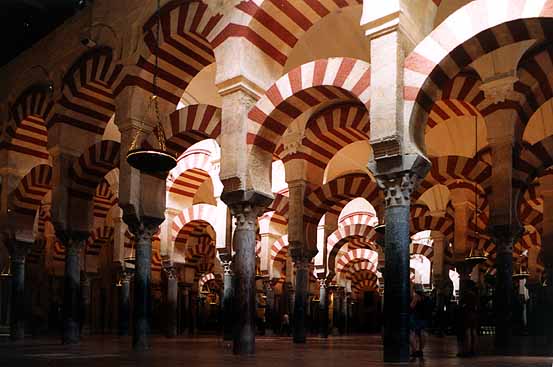 Mezquita, Cordoba
Mezquita, CordobaThe reason why Spain stands out from the rest of Europe stems from its Muslim origins. Eight hundred years of Islamic political power and culture in Andalucia centred in Cordoba (756-1031), then Sevilla (1040-1248) and lastly Granada (1248-1492). We spent one week visiting World Heritage-listed palaces, baths, gardens and mosques in each of these cities.
 Mezquita, Cordoba
Mezquita, Cordoba
Built in 785 AD and enlarged several times to accommodate a growing number of worshippers, the Mezquita is constructed from 1,300 stone columns, graced by red and white stone arches. Underneath the arches and the low wooden ceiling, it felt as if we were standing in a forest; sheltered and comforted by the low light and stillness.
In 900 AD, Cordoba was the largest city in Western Europe. The Mezquita, able to accommodate thousands of worshippers, provided a powerful symbol of the power of the Islamic empire that expanded from the length of the Iberian Peninsula into northern Africa.
By the 16th century, Andalucia had passed from Islamic to Catholic rule and the centre of the mosque was demolished for the construction of a Baroque cathedral of white marble. The cathedral has no walls; instead it is surrounded on all sides by forest of the original pillars. It was a shock to suddenly walk from the mosque into the cathedral. The ceiling now dramatically three times higher and as my eyes were drawn upwards, towards the heavens, I felt very small, for the first time.
 Alhambra, Granada
Alhambra, Granada
The Al-qala at Al-hamra (Red Castle) was built as a fortress in the 9th century. Yet the Alhambra, owes its beauty to the Nasrid dynasty, the last of the Islamic rulers in the 13th and 14th centuries.
Only the beauty of the Taj Mahal can compete with the elegance and detailed finery of the Nasrid Palaces within the Alhambra. These pictures illustrate the Patio de la Alberca (Patio of the Pool). Water is a central tenant of Islamic culture, as water brings life to the desert, is used to wash oneself before worship, and both cools the courtyard and inspires serenity.
 To the north and south of the courtyard, delicate arches sit on top of marble pillars. The intricate designs that compose the arches were created from plaster poured into carved wooden moulds. This allows the minute geometrical patterns to be repeated again and again with accuracy.
To the north and south of the courtyard, delicate arches sit on top of marble pillars. The intricate designs that compose the arches were created from plaster poured into carved wooden moulds. This allows the minute geometrical patterns to be repeated again and again with accuracy.
 Alzacar, Cordoba
Alzacar, Cordoba
Beyond the markets, mosques and palaces, the Muslims left another imprint in Andalusia - a tradition of running water and flowering plants.
In every village, even the smallest window ledge is crammed with flowers, facades of terrace houses are speckled with flowerpots and the narrow streets open to fountain filled squares.
Each city is graced with a maze of many tiny gardens, all with a fountain or pool as a central focus, which complement the principal residence. In Granada, this is the Generalife and in Sevilla and Cordoba, the Alcazar.
 Catholic Andalucia
Catholic Andalucia
As Catholic power descended from northern Spain, many Muslims fled to Granada or northern Africa. By the early 16th century, Spain was united under single rule for the first time in over one thousand years. To achieve this, the Catholic Monarchs, Isabel and Fernando, revived the Inquisition to remove those seen as a threat to the authority of the Catholic Church. Over 300 years, the Inquisition was responsible for 12,000 deaths; 2,000 in one year of Isabel's rule.
Today, 85% of those living in Spain are Catholic. Because religious festivals contribute heavily to the social life of a village, Miguel Unamuno joked, "Here in Spain we are all Catholics, even the atheists".
 Columbus' Tomb, Sevilla
Columbus' Tomb, Sevilla
"In fourteen hundred and ninety-two, Columbus sailed the ocean blue..." ...and again in 1493, 1498 and 1502.
On not one of those four voyages, did Columbus ever reach mainland USA; instead he discovered the Bahamas, Cuba, Jamaica, Caribbean Islands, Honduras and Panama. He thought, even at his death in Spain in 1506, that he had reached Asia. However, his impressive tomb in Sevilla Cathedral is much visited and photographed by American tourists and his discoveries funded many of the lavish Renaissance and baroque buildings in Sevilla today.